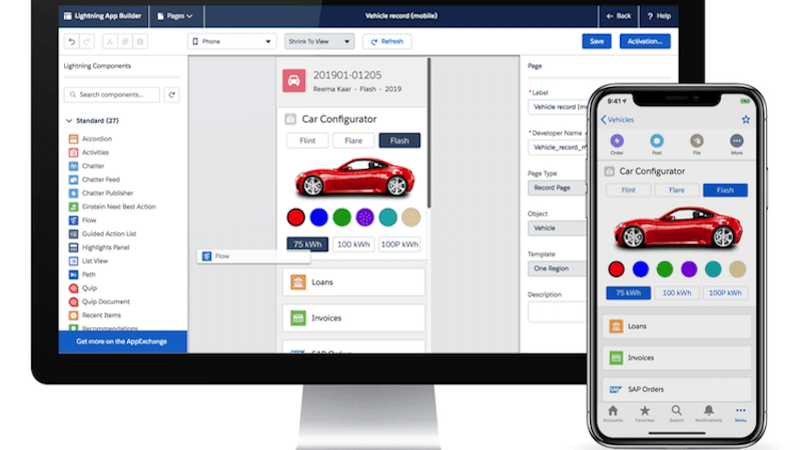New Salesforce tools let marketers create mobile apps without developers
Now, marketers and admins can create and publish iOS and Android apps with pre-built components and a few clicks.
Salesforce is adding on Thursday the ability for marketers and admins to create and publish mobile apps for iOS and Android devices on its Lightning Platform and for its Community Cloud.
The new Lightning Platform Mobile offers three tools for this app development platform.
Builders, Services and Publisher. Mobile Builders, a “low-code development environment,” includes pre-built JavaScript components, so that Salesforce admins can create apps all on their own. Spreadsheets can be converted into apps, and the data model and UI are created with a few clicks. Nearly two hundred pre-built components are also available in the Salesforce AppExchange.
An accompanying Mobile Services lets users integrate Salesforce’s Einstein AI layer, third-party data or mobile push notifications with a few clicks.
And a new Mobile Publisher lets admins publish the apps directly to the App Store or Google Play, with Publisher handling the packaging and submission.
The company pointed to the use of Lightning Platform Mobile by Dutch supermarket chain Jumbo to create an employee app for internal collaboration and task management, and a customer app for nutritional info and same-day delivery orders, both of which were created within eight weeks.
Mobile Publisher for Community Cloud. In addition to the mobile app creator for the Lightning Platform, Salesforce is also announcing today a version of Mobile Publisher that is optimized for Community Cloud.
In Community Cloud, brands create and manage CRM-connected online communities, portals and forums so that customers and other users can communicate with each other and the brand about the company’s products.
The Community Cloud Publisher lets marketers create a mobile app version of the brand’s web-based community with a few clicks. If a brand updates the web community with new features or content, the app version will automatically be updated as well.
After logging into the app, users can close and re-open it without having to login again, and can access local files or photos on the mobile device for uploading to the community. No third-party integrations are required.
In the Community Cloud version of Publisher, marketers just need to add their app icon, enter a description and metadata, upload a splash screen and make a few other selections, with less technical skills than the admins using the Lightning Platform Mobile Builder.
Previously, developer skills were required to build an app on either the Lightning Platform or the Community Cloud. For communities, the resulting app was not a Community standalone, but was part of a larger Salesforce app.
In one use case of the new Community Cloud Publisher, Cornell University turned their student portal into an app, which the school felt would better appeal to that generation.
Why you should care. According to Salesforce research, 48 percent of IT departments have “a significant mobile developer skills gap,” and another 33 percent expects such a gap in the new two years. And venture capital firm Kleiner Perkins has found that about half of users’ daily six hours of internet usage is on mobile devices.
With this kind of needs versus skills, a builder/publisher for admins and marketers with light technical skills could fill a need to create more fluid experiences for employees, customers and prospective customers.
Mobile apps provide a more fluid experience than many mobile web sites, although Progressive Web Apps are beginning to change that balance. The ability to quickly create and publish mobile apps, without a lot of help from software developers, lets marketers provide this option to customers and audiences.
Opinions expressed in this article are those of the guest author and not necessarily MarTech. Staff authors are listed here.
Related stories

